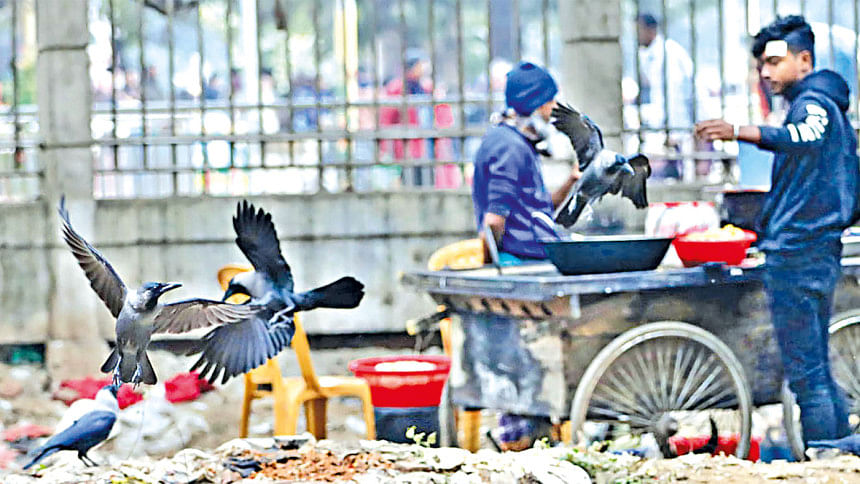Once a staple of every morning in cities across Bangladesh, the unmistakable caw of the crow is now becoming a rare sound. These intelligent, adaptable birds—long associated with urban life—are quietly disappearing. While many once viewed crows as mere scavengers or nuisances, their decline is now raising alarms among environmentalists, city planners, and ecologists alike. The connection? Climate change. And its consequences ripple far beyond birdsong.
Crows: Nature's Unpaid Waste Workers
For decades, crows served as a silent force in waste management. In cities like Dhaka, Chattogram, and Rajshahi, they played a critical role in scavenging food scraps and organic waste from open bins and streets. Without them, organic waste now rots longer, attracting flies, rats, and disease.
Md Rafiq, a waste collector from Dhaka North City Corporation, laments, "Ten years ago, the garbage bins would be cleaned by crows before we arrived. Now the same bins overflow and stink by noon."
Crows play a natural role in reducing biodegradable waste, supporting a system already strained by rapid urban population growth and inadequate waste management infrastructure.

A Silent Collapse
According to data from Jahangirnagar University's Department of Zoology, Bangladesh's crow population has declined by more than 60% in major urban areas since 2010. The reasons are complex but interlinked:
Rising Temperatures: Heatwaves disrupt breeding cycles and reduce chick survival.
Habitat Loss: Urban expansion and tree-cutting reduce nesting areas.
Toxic Waste: Formalin-laced food, pesticides, and industrial waste poison birds indirectly through scavenging.
Air Pollution: Increased levels of airborne pollutants impair respiratory health in birds, especially in Dhaka, where PM2.5 levels regularly exceed WHO guidelines.
"This is a textbook example of an ecological collapse. Crows were once seen as dirty. Ironically, their absence is making our environment filthier," says Dr Rezaul Karim, ornithologist and conservation adviser.
A Broken Chain in the Urban Ecosystem
The crow is a keystone species in urban Bangladesh. Its decline has triggered a cascade of imbalances:
Increased Rat Population: In the absence of avian scavengers, rodents thrive.
Mosquito Breeding: Decaying waste becomes fertile ground for mosquito larvae.
Dog–Human Conflict: With crows gone, street dogs are turning to garbage for food, increasing their presence and often leading to more human–animal conflict.
Rise in Zoonotic Diseases: Unmanaged organic waste and greater contact with rodents and dogs increase the risk of disease transmission to humans.
Moreover, crows were natural pest controllers in rural areas, feeding on insects that damage crops. Their absence has led to greater pesticide use, further harming biodiversity and soil health.
Climate's Cruel Hand
Bangladesh has experienced a steady rise in average temperatures—1.3°C over the past 20 years. Rainfall patterns have become erratic, and prolonged dry spells are stressing urban greenery, which crows depend on for shelter.
"Extreme weather events like storms and sudden rain now destroy many nests before the eggs hatch," explains Dr Mahzabin Akter, an ecologist with IUCN Bangladesh. "Climate change is disrupting not only birds' life cycles but the entire urban food web."
Human Responsibility: Ignored for Too Long
Beyond climate change, human decisions have hastened the decline. In some areas, local authorities reportedly used poisoning or nest destruction near hospitals and airports to curb crow activity—moves that now appear tragically short-sighted.
Urban development rarely includes planning for biodiversity. Cement replaces soil, and ornamental plants replace fruit-bearing or native trees, leaving fewer food sources for birds.
What Can Be Done?
Rebuilding the crow population—and broader urban biodiversity—requires targeted action:
Plant Native Trees: Neem, mango, and banyan trees provide nesting areas and food.
Ban Open Waste Dumps: Shift to sealed bins and composting methods.
Regulate Harmful Chemicals: Control formalin, pesticides, and toxic food waste.
Raise Public Awareness: Educate citizens about the ecological role of urban wildlife.
Integrate Biodiversity into Urban Planning: Make space for nature in the city.
"We need to stop thinking of crows, or any scavenger, as pests. They are critical service providers. Nature gave us free cleaners—we drove them away," says Dr Karim.
A Warning in the Silence
The disappearing crows are more than just an ecological footnote—they are a warning. Climate change does not just melt ice caps or flood coastlines. It disturbs the balance in our neighbourhoods, our streets, our daily routines.
As Bangladesh steps into a hotter, more unpredictable future, we must decide: will our cities continue to push nature away, or will we make space for the very species that have helped us survive?
In the eerie silence of crow-less mornings, the answer grows urgent.
Afrina Momotaj is a climate-smart agriculturist and animal rescuer.


Comments